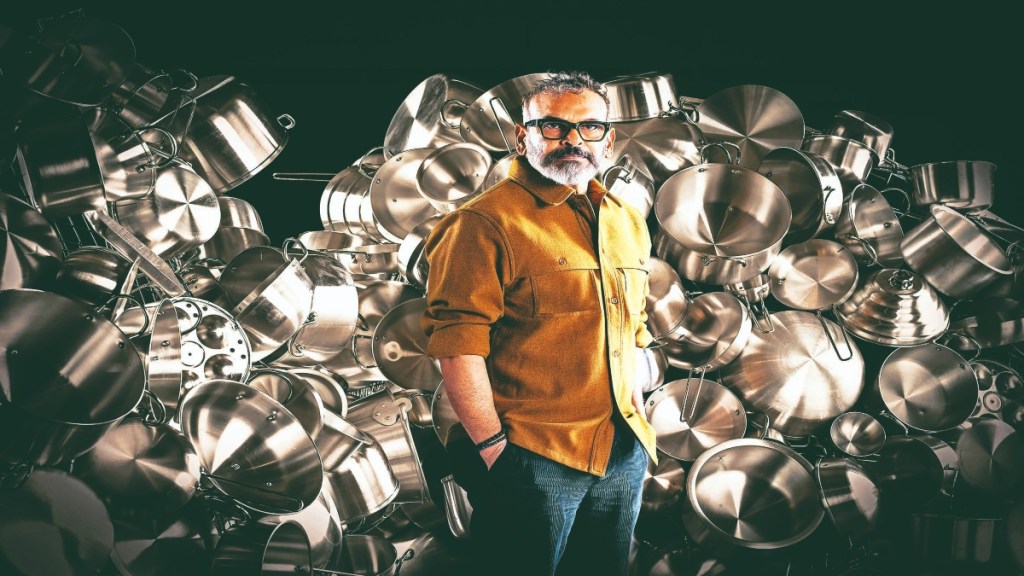In his first major show The Way Home at the Bihar Museum in Patna, contemporary artist Subodh Gupta gathers sculptures and paintings linking him with his roots and memories that have defined his long career. The exhibition, which opens to the public on November 10, and runs up to February 15, has 20 sculptures and a select group of paintings from 2003 to 2024. Gupta, whose works have found home at well-known museums around the world, making him one of the most influential Indian artists today, deals with the personal to comment on the overarching reality and pays tributes to the migrant workers from Bihar for their seldom-acknowledged contributions to nation-building. In an email interview with FE, Gupta, who dedicates the exhibition to his mother, talks about the significance of the show in his home state, inspiration from his roots and his international collaborations. Edited excerpts:
Is The Way Home your most personal exhibition yet? Why did it take such a long time for a major exhibition in your home state?
It feels incredible to be exhibiting in Patna, my hometown, after so many years; so this is truly a special moment. The Way Home represents my connection to my country as well as my birthplace and the show is a coming home of sorts and going back to the roots of it all. College, family, the railways. So much of my work over the years have been returning here. I always believe that things happen when they are supposed to happen and this museum was only built nine years ago. There aren’t really many places large enough for a show of this scale. The Bihar museum that I’m showing in is by far the most beautiful and incredible contemporary public building built in the past 50 years in India.
The idea of home has been the essence of your artistic practice. How would you distinguish between home and your own roots?
My upbringing has played a significant role in my work. I came from a large middle-class family that lived close to each other, so day-to-day life in a small railway town was familiar and warm. This is where I am from and these are my roots. When I began working as an artist, my observations and deep connection to my surroundings naturally became the foundation of my work and over the years I have built on that language. Essentially however, I return to the humble object because that’s what I know and am familiar with.
The Way Home is your first major exhibition after you faced personal and professional setbacks a few years ago that eventually ended in a court verdict in your favour. What has been the impact of the setbacks on you personally and has the new show been a therapeutic experience?
Life has taught me a lot; family is your absolute strength and anchor, true friends keep you grounded and my art kept and continues to keep me going through thick and thin, like a soul companion. Painting became the space for me to speak. This show takes me home to my mother’s home state. I dedicate this show to her memory.
What are the memories from growing up that are at the core of creativity in works like Door and Gehri Neend and the other new works of the exhibition?
Doors are continuously opening and closing. They signify possibilities, dreams and also endings. This is a central work in the show for me because it says so much. Gehri Neend is about the sleep of dreams, when you enter another world that is not your human one. It’s the sleep of death that has been written about, from greats like (William) Shakespeare to (John) Keats. ‘Can death be sleep, when life is but a dream,’ to quote Keats. Kabir Das also spoke about sleep as death; in the first line of a doha, he says that sleep is an indication of death, where he was really talking about our unawareness in our living life. I felt that resonance growing up in a family where there was a lot of tragedy.
How do you relate your artistic expression to what many consider a New India today?
Growing up in Bihar has kept me grounded, and I love that reality. However, when you look at our nation, the middle-class experience is not so different across the country—our behaviour is similar. Yet the social and economic change has been rapid. I feel my work, my career, has grown in the same way, very quickly at first but now evolving with time. Yet all the while staying rooted in the shared experiences of us as witnesses of the rapid growth of India. Politics has become much more contested and polarised and those contradictions always show up in the work as metaphors. In the work Tasveer, for example, I have placed used old chappals and shoes on the thali as a symbol of our workers from Bihar.
How has The Way Home transformed you as an artist? Would there be more shows and even a studio in Bihar in the future?
I can’t say yet really; but if there are places to make exhibitions across India, nothing would give me greater pleasure than sharing my work with the people here, whether in Bihar or elsewhere. As to having a studio here… that could be a beautiful idea; there are parts of the countryside in Bihar that are so beautiful, replete with mango orchards and vast landscapes.
Lebanese collaborating artists Joana Hadjithomas and Khalil Joreige, who were Venice Biennale participating artists, whom I met earlier this month talked of their keenness to collaborate with you in the future. What are your plans for such international collaborations?
I have made many international collaborations over the years and it always depends upon the ideas and the relationship you develop with other artists. In 2010, I collaborated with Ballet Preljocaj for the Bolshoi Theatre in Moscow, where I designed the sets and costumes over two years. Collaborations can be great, and one learns a lot from them.








